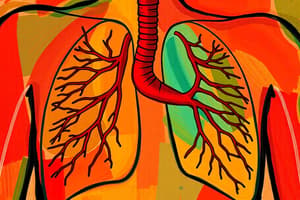Podcast
Questions and Answers
What is a characteristic of an open circulatory system?
What is a characteristic of an open circulatory system?
- It operates under high pressure.
- Blood is contained within vessels.
- It is found in vertebrates.
- Hemolymph bathes organs directly. (correct)
Which of the following components is involved in the closed circulatory system?
Which of the following components is involved in the closed circulatory system?
- Trachea
- Gills
- Blood vessels (correct)
- Hemolymph
What type of respiratory system is primarily used by terrestrial vertebrates?
What type of respiratory system is primarily used by terrestrial vertebrates?
- Skin respiration
- Gills
- Lungs (correct)
- Tracheal system
What triggers the action potential in a neuron?
What triggers the action potential in a neuron?
Which process refers to gas exchange between the environment and the blood?
Which process refers to gas exchange between the environment and the blood?
Which type of neuron is responsible for transmitting signals to muscles?
Which type of neuron is responsible for transmitting signals to muscles?
What is the primary function of capillaries in the circulatory system?
What is the primary function of capillaries in the circulatory system?
In which nervous system component does signal processing primarily occur?
In which nervous system component does signal processing primarily occur?
Study Notes
Circulatory Systems
- Function: Transport nutrients, gases, hormones, and waste products throughout the body.
- Types:
- Open Circulatory System:
- Found in arthropods and some mollusks.
- Hemolymph bathes organs directly.
- Low pressure system.
- Closed Circulatory System:
- Found in annelids, cephalopods, and vertebrates.
- Blood contained within vessels.
- Higher pressure allows for efficient transport.
- Open Circulatory System:
- Components:
- Heart: pumps blood.
- Blood Vessels: arteries (away from heart), veins (towards heart), capillaries (exchange).
- Blood: composed of red blood cells, white blood cells, platelets, and plasma.
Respiratory Systems
- Function: Exchange of gases (oxygen and carbon dioxide) between the organism and environment.
- Types:
- Gills:
- Found in fish and amphibians.
- Extract oxygen from water.
- Lungs:
- Found in terrestrial vertebrates.
- Facilitate gas exchange in air.
- Tracheal System:
- Found in insects.
- Network of tubes delivering air directly to tissues.
- Gills:
- Process:
- External Respiration: gas exchange between the environment and blood.
- Internal Respiration: gas exchange between blood and body cells.
Neurophysiology
- Function: Study of the physiological properties of neurons and neural circuits.
- Neurons:
- Structure: Dendrites (receive signals), cell body (processing), axon (transmits signals).
- Types: Sensory neurons, motor neurons, interneurons.
- Action Potential:
- Electrical impulse that travels along the axon.
- Triggered by depolarization of the neuron's membrane.
- Synapses:
- Junctions where neurons communicate.
- Involve neurotransmitters that transmit signals between neurons.
- Reflex Arc:
- Neural pathway that controls a reflex action.
- Involves sensory neuron, spinal cord, and motor neuron.
- Central and Peripheral Nervous Systems:
- Central: brain and spinal cord, processing and integration.
- Peripheral: nerves outside the brain and spinal cord, transmitting signals to and from the central system.
Circulatory Systems
- Function: Essential for transporting nutrients, gases, hormones, and waste products throughout the body.
- Types:
- Open Circulatory System:
- Present in arthropods and some mollusks.
- Hemolymph directly bathes organs, resulting in a low-pressure environment.
- Closed Circulatory System:
- Found in annelids, cephalopods, and vertebrates.
- Blood circulates within vessels, generating higher pressure for efficient nutrient and gas transport.
- Open Circulatory System:
- Components:
- Heart: Central organ responsible for pumping blood.
- Blood Vessels:
- Arteries transport blood away from the heart.
- Veins carry blood toward the heart.
- Capillaries facilitate nutrient and gas exchange at the cellular level.
- Blood Composition: Includes red blood cells, white blood cells, platelets, and plasma.
Respiratory Systems
- Function: Vital for exchanging gases (oxygen intake and carbon dioxide removal) between organisms and their environment.
- Types:
- Gills:
- Specialized for aquatic organisms like fish and amphibians, extracting oxygen from water.
- Lungs:
- Adapted for terrestrial vertebrates to enable gas exchange with air.
- Tracheal System:
- Unique to insects, consisting of a network of tubes that transport air directly to tissues.
- Gills:
- Process:
- External Respiration: Involves the exchange of gases between the environment and blood.
- Internal Respiration: Gas exchange that occurs between the blood and body cells.
Neurophysiology
- Function: Involves the study of the properties and functions of neurons and neural circuits.
- Neurons:
- Structure: Comprised of dendrites (signal reception), cell body (signal processing), and axon (signal transmission).
- Types: Sensory neurons (detect stimuli), motor neurons (elicit responses), interneurons (connect sensory and motor pathways).
- Action Potential:
- An electrical impulse traveling along the axon, initiated by depolarization of the neuron's membrane.
- Synapses:
- The location of communication between neurons, utilizing neurotransmitters to transmit signals.
- Reflex Arc:
- A neural pathway controlling reflex actions, involving a sensory neuron, spinal cord, and motor neuron for quick responses.
- Nervous Systems:
- Central Nervous System: Comprises the brain and spinal cord, responsible for processing and integration of information.
- Peripheral Nervous System: Consists of nerves outside the brain and spinal cord, responsible for transmitting signals to and from the central system.
Studying That Suits You
Use AI to generate personalized quizzes and flashcards to suit your learning preferences.
Description
Test your understanding of the circulatory and respiratory systems, including their functions, types, and components. This quiz covers open and closed circulatory systems and gas exchange mechanisms in different organisms. Challenge yourself to see how well you know these essential systems in biology!



